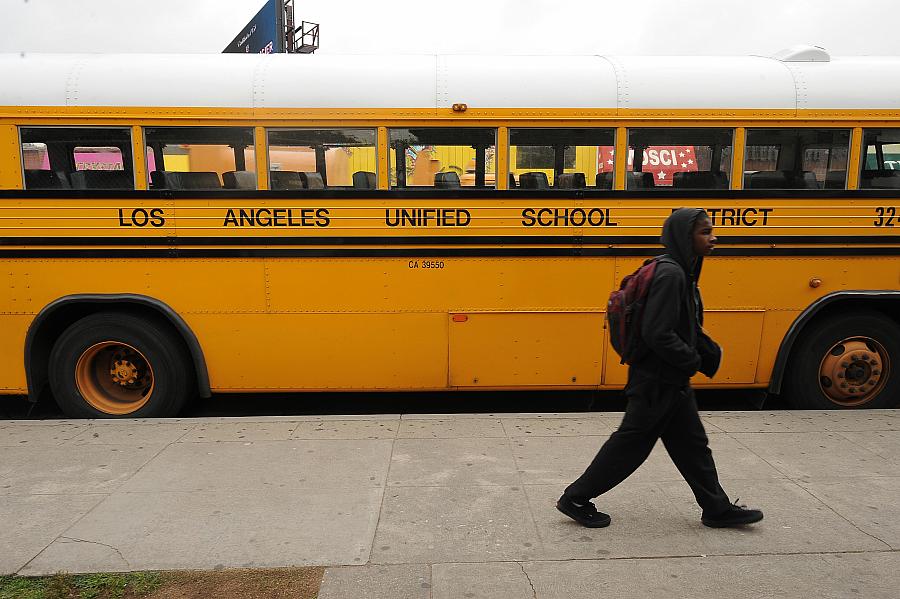In Los Angeles, a school district wrestles with epidemic levels of childhood trauma

Keljawn and his family know devastation.
The 15-year-old South L.A. resident lost his 4-year-old brother in 2016, when a car hit him while he was playing in a driveway. Then, last year, Keljawn’s mother gave birth to twins. One was stillborn, and the other died at eight months, after surgery.
“At one point in time, I just wanted to give up,” Keljawn said, sharing his story with a room full of journalists visiting the Locke Wellness Center in South L.A. to learn more about how the Los Angeles Unified School District is trying to address epidemic levels of trauma in the second-largest school district in the nation.
Keljawn saw his grades suffer. He struggled to stay focused in class. But he was willing to start talking to a therapist who made routine visits to his high school. Javier, the therapist, started teaching him coping strategies and how to shift his attention to the positive things in his life. “Go outside, reset, feel the breeze,” as Keljawn put it.
“You can’t focus when you’re mad, you’re angry,” he said.
He’s completed nearly two years of therapy. These days, his grades are improving, and he’s focused on finishing high school and going to college to study nursing or maybe engineering. “Make my mom and dad proud,” Keljawn said.
Trauma and toxic stress are facts of life for many of LAUSD’s nearly 650,000 students, 80 percent of whom live in poverty. When the district screened nearly 2,500 students last year, 40 percent reported not feeling safe, and 26 percent were at high risk for traumatic stress, according to Pia Escudero, director of school mental health for the district. Nightmares, hypervigilance, feelings of numbness and avoidance behaviors were common among the students screened.
Across the street from Locke High School sits the Locke Wellness Center, where students such as Keljawn can receive therapy, medical care and even dental care. Psychiatric social workers and clinicians there practice trauma-informed treatments, such as trauma-focused cognitive behavioral therapy (TF-CBT). Over weeks and months, therapists teach trauma survivors how to turn their experiences into a story — it could be a song, or a piece of art, or just a new perspective — that helps them process their experience. They also learn coping skills to manage the pain and anxiety.
“We see a lot of anxiety, depression, suicidal thoughts, cutting behaviors, a lot of disruptive behaviors,” said Suzanne Markey, a mental health specialist with the school district. “But I would say [that for] most, if not all, of the clients we work with, we uncover the underlying issue of trauma. That’s the majority of what we’re treating.”
The district’s 15 Wellness Centers, which opened in 2012, are clustered in traditionally underserved areas, such as the Harbor Corridor in South Los Angeles. The centers combine primary care and mental health, and cater to students — they offer a separate entrance for teens — as well as the community at large. They are places where a high school student could get tested discreetly for STDs, see a therapist, or get a sports physical, all in the same building.
But the centers aren’t just for older students. Therapists at the Locke Wellness Center work with children as young as two. In two small adjoining rooms connected by a one-way mirror, a clinician watches as young children play at a table with a parent, while offering suggestions through the parent’s earpiece about how he or she can interact with the child in healthy, positive ways.
“The goal is to teach the parent or caregiver to improve the relationship and communication between them and their child,” Markey said.
The needs in these communities are daunting. While one-on-one therapy can be potentially life-changing for students like Keljawn and families who seek it out, the district knows the scope of the problem vastly exceeds available resources. The district’s suicide rates are higher than ever, according to Escudero. “The ones who come to therapy are really the privileged ones,” she said.
The district has partnered with UCLA’s Nathanson Family Resilience Center to adopt a classroom curriculum, originally devised for military families, that teaches coping and problem-solving skills, along with a series of mental health screenings. From there, students who need it can be referred to cognitive behavioral group therapy for trauma — more than 700 students went through the district’s program last year, according to Escudero.
And while not every student has a therapist, they all have teachers. That’s why the district is trying to make sure teachers and parents know how trauma can affect students, and how they might better respond to the behaviors that ensue.
“What we’re really trying to do, most importantly, is teach teachers about trauma,” said Escudero. “That child that’s misbehaving and that demands so much attention and bugs you the most is probably the one that needs you the most.”
That echoes Keljawn’s own message to teachers, a piece of advice born from experience.
When a teacher sees a student acting up or behaving poorly, Keljawn said, “Give them a little push, help them.”
[Photo: Robyn Beck/AFP/Getty Images]
